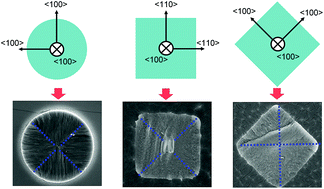Facile fabrication of sponge-like porous micropillar arrays via an electrochemical process†
Abstract
A large variety of synthetic methods have been developed for hierarchically porous materials by which the performance of a wide range of applications can be dramatically enhanced. Herein, hierarchically porous micropillar arrays are demonstrated by employing electrochemical etching to silicon micropillars. The approach relies on the steering of current flow through the three-dimensional silicon–electrolyte interface to enable nanopores to grow on the entire surface of the micropillars, simultaneously. The pores grow perpendicular to the surface of the micropillars, whereas the pore diameter and porosity vary depending on the locations of the surfaces. The finite element analysis shows that the spatial variation of the pore diameter and porosity is determined by the distribution of current density. Further, the thickness of the porous layer can be tuned by etching time so that sponge-like porous structures are conveniently obtained by regulating the etching time. In addition to the effect of current density flowing through the etched surfaces, the growth of pores also depends on the crystal orientations of the etched surfaces. The etching results on square micropillar arrays and microgroove arrays show that the growth direction and rate of nanopores inside the microstructure also depend on the exposed crystal planes. The facile characteristics of the fabrication method can serve as an effective route for a wide range of applications of porous materials with enhanced capabilities.



 Please wait while we load your content...
Please wait while we load your content...
